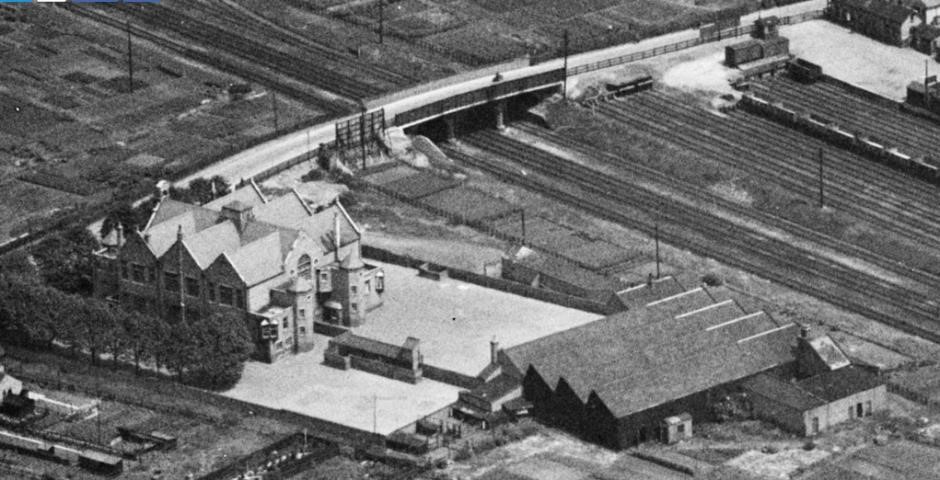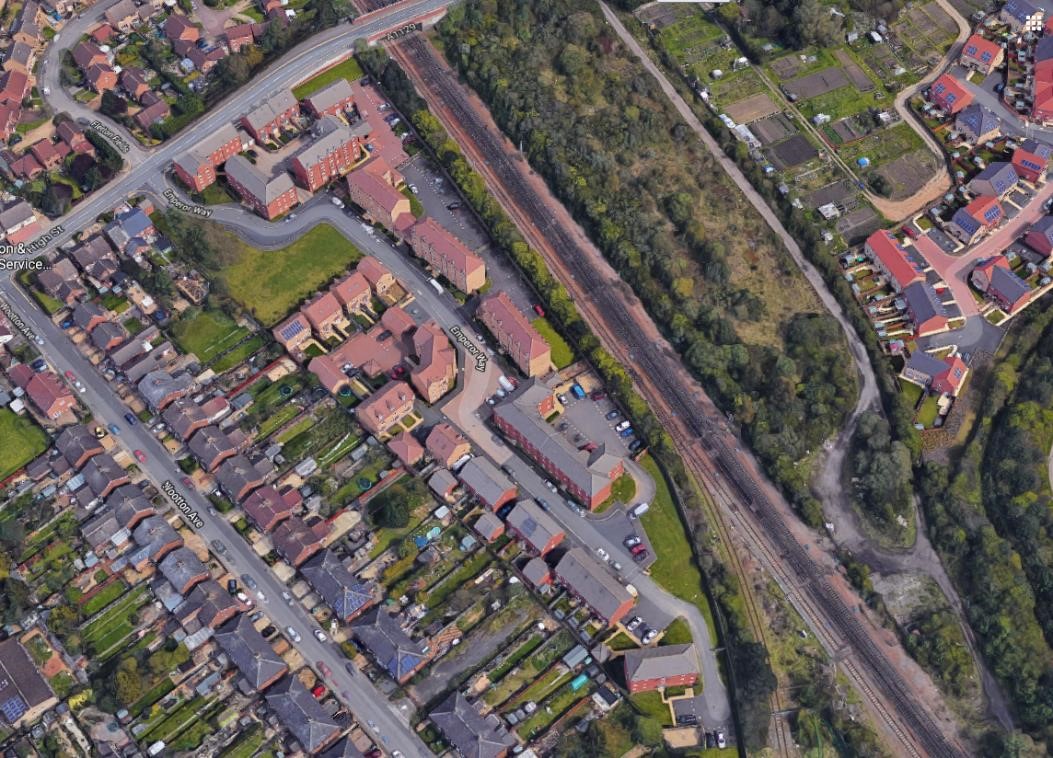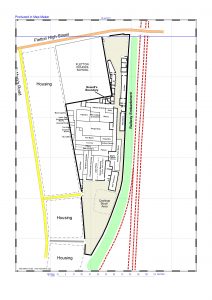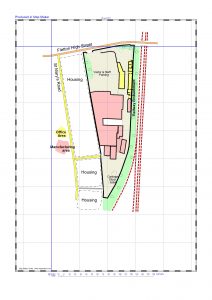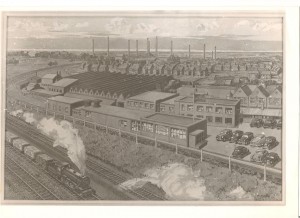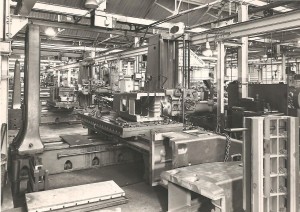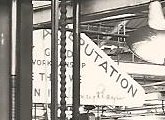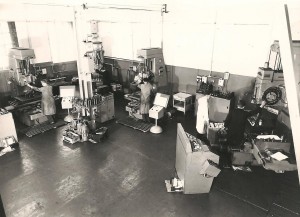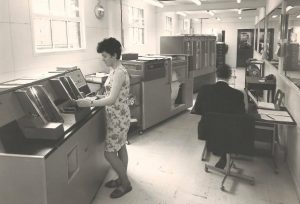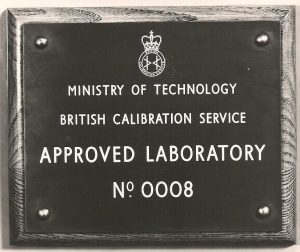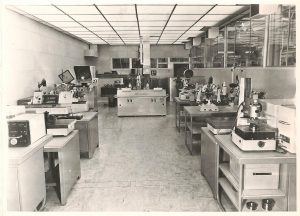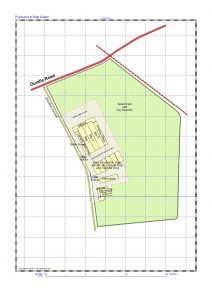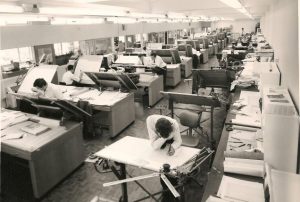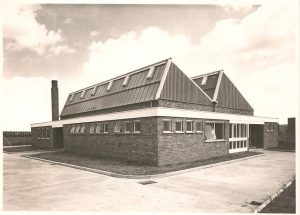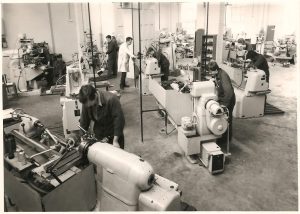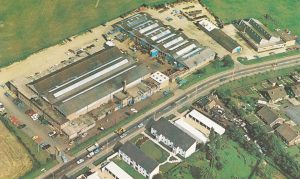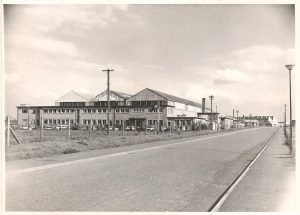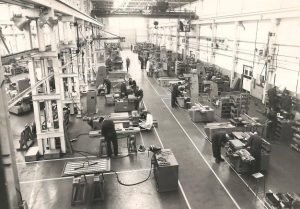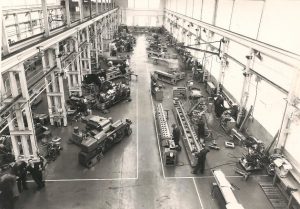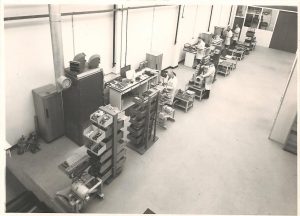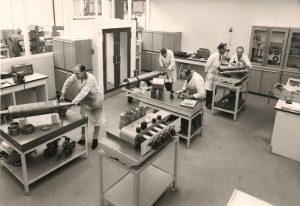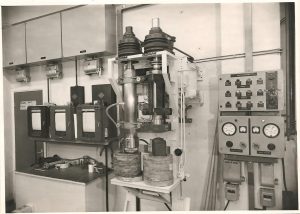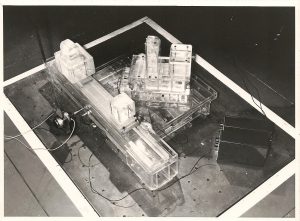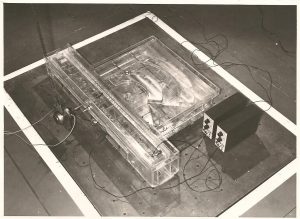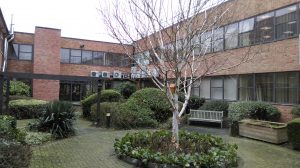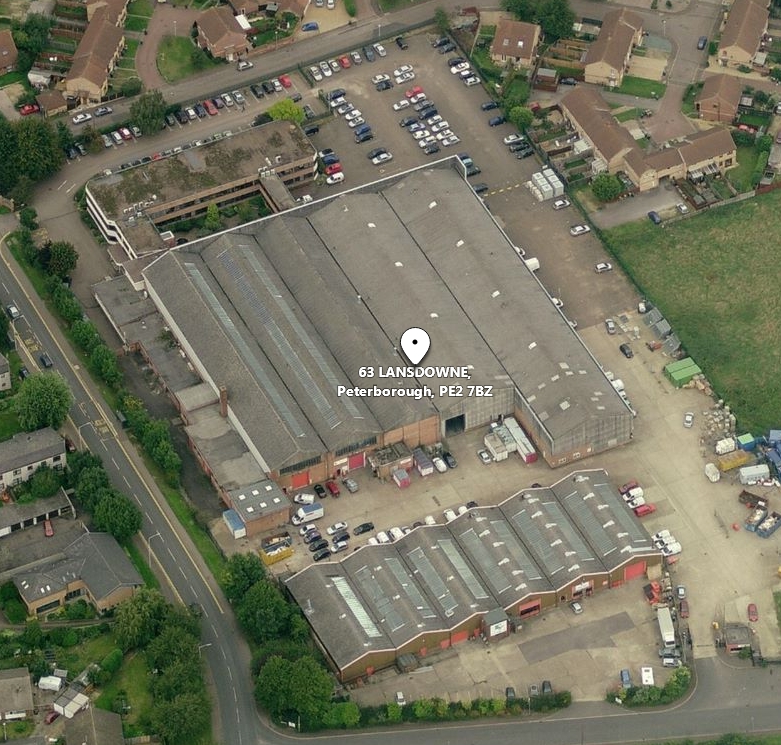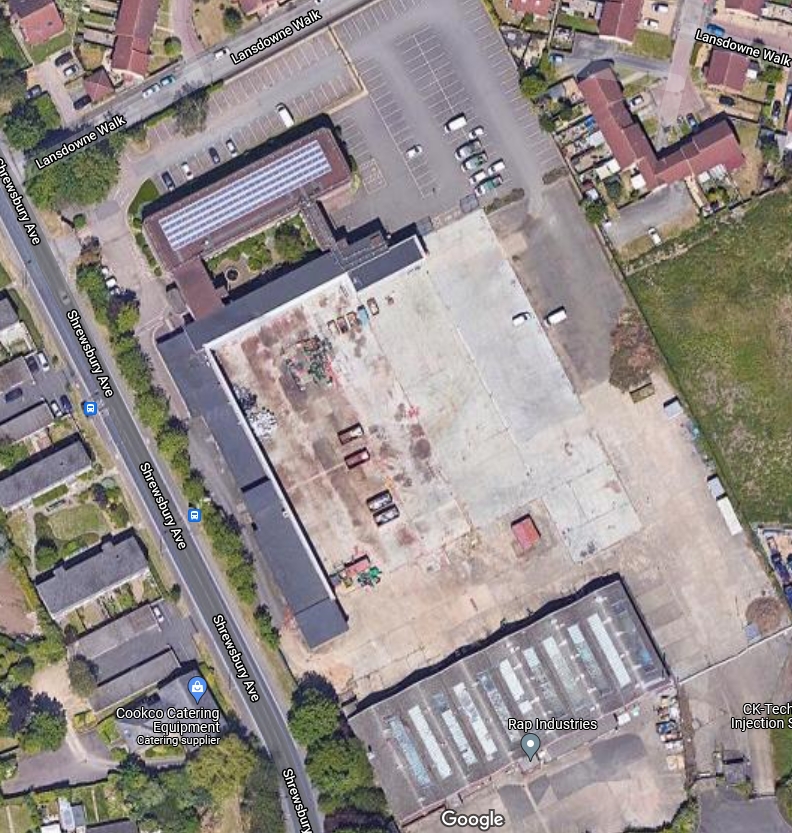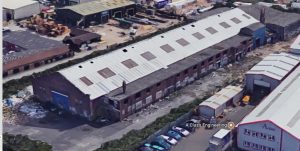This web page was last updated in October 2023.
The ‘Factories’ page was first created as part of the Newall Engineering Company page in 2016. Much more detail has been added, and this separate page was published in May 2017. In common with all the other pages on this website, we ask that if you are aware of any errors, or would like to add further details or personal memories, please email us – in this case to mike@newall.org.uk.
The Newall Engineering Company machine tool business operated from three factories within Peterborough:
- Fletton High Street – No.1 factory
- Shrewsbury Avenue – No.2 factory
- Padholme Road – No.3 factory
For information relating to other factories within the group, refer to their individual page on this website.
The Old Fletton Works (No.1 factory).
March 1935 – Mid 1970’s.
Located in High Street, Old Fletton, and acquired from Atkins (Peterborough) Ltd at the end of March 1935, this was Newall’s first Peterborough factory. Following the move from Ponder’s End in Middlesex, this became the primary production centre for the company, from which all its products were designed, machined, and assembled. Later, when other factories were opened in Peterborough, the site became known as No.1 factory.
Here is a photo of the factory in 1934 right at the end of the Harry F. Atkins era. It is interesting to see how the plant expanded in the following 9 years as you can see in the plans which follow. This photo also gives an exceptionally good view of the size and location of the Council School (where the author spent some of his formative years!). The entrance to the factory site was from Old Fletton High Street, just this side of the railway bridge.
Here is an image of the same area in 2018.
A new road named “Emperor Way” serves a modern housing development as it winds its way across the site of the old school before continuing down through where the bulk of the Newall factory once stood. Part of the old school junior playground has been retained as the grassed area towards the top left of the picture, and they have even managed to retain one or two of the old trees that grew just inside the boundary wall of that playground.
From information in the 1944 Ministry of Home Security survey, we created a plan of the site, showing the production and office areas – click on the image to enlarge.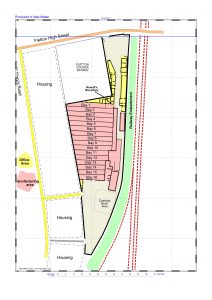
Below is a second plan which provides more detail relating to the machining, assembly and stores areas. Again, click on the image to enlarge.
Both these plans relate to the factory in 1944, and at that time, Fletton Council School (later known as Old Fletton County Primary School) stood at the north-west corner of the factory.
In 1959, the Primary School re-located to the site of the old grammar school at the Fletton High Street / London Road junction, after it moved to a new building in Orton Longueville, and the old Fletton Primary School was demolished.
Newall acquired the old Primary School site (see 3rd plan on the left), which enabled the company to make improvements to the office space, to provide more parking space for employees and visitors, and to improve access from Fletton High Street. Other changes were made to some of the production facilities, and to widen access to the southern end of the site.
In the late 1950s, some of the machine assembly work was transferred to a recently built factory at Shrewsbury Avenue (No.2 Factory). The Fletton High Street (No.1 factory) continued as the primary site for parts manufacture, sub-assembly build, design and drawing office activities, and production control. Over the next 20 years, more of this work was moved to the No.2 factory, and in the early 1970s, the Fletton High Street factory closed.
The company continued to own the site until agreement could be concluded with a new buyer in 1976/77. After a brief spell as premises for the Metal Box company, the factory buildings were demolished, and replaced with housing (see image above, showing the site in 2018).
[[Below are a number of photographs – our thanks to Ray Morris. In many cases, click on the image to see a full-size view of the picture.]]
The picture on the left is a copy of an artist’s impression of the factory. We suspect that the Newall logos on the sides of the train’s goods wagons are not authentic!
The picture on the right is of the horizontal boring section. The casting being machined here is the column of a jig borer.
The image below is an enlarged section of the previous photo which encourages the company’s employees to work to maintain the company’s reputation for quality.
We understand that the wording on this sign says “We have a reputation for good workmanship, see that we maintain it.” [[The notice appears to be signed at the bottom right by Sydney Player – though we cannot be certain about this.]]
On the right is a photograph of the jig borer section at the No.1 factory. It was said by a senior member of the sales team that being able to show potential customers that Newall were using their own designed and built jig borers to manufacture parts to a very high tolerance, demonstrated the company’s confidence in their product.
The picture on the left shows the company’s “computer room, housed in a modernised part of the No.1 factory”. We suspect that this computer had less computing power than a typical PC these days (2017), and less memory that a 1GB memory stick!
We believe that the computer power supply used a 30KVA motor-generator set, with the generator driven by an electric motor. Later, when that was no longer required, the generator was coupled to a 6-cylinder BMC diesel engine to become an emergency lighting supply at No. 2 factory.
The company built a specialist laboratory to provide engineering test/research facilities. This laboratory was “Ministry of Technology approved to provided closely controlled temperature and humidity conditions, and contained inspection equipment of the highest quality”.
A similar temperature controlled facility was constructed at the southern end of Bay 3 at the No.2 factory. In this case, the room was used primarily for final testing and customer approval of jig borers prior to delivery.
Shrewsbury Avenue Works (No.2 factory)
July 1957 – April 1986
Newall acquired a significant plot of land adjacent to Shrewsbury Avenue, Woodston, Peterborough. This site evolved over a number of years , eventually to become Newall’s main centre in Peterborough. There were three main phases of development as follows:
PHASE 1.
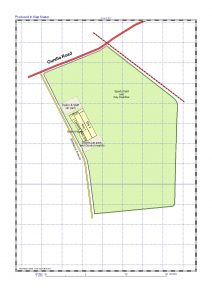 A new factory consisting of two large assembly bays, and a number of offices, was constructed covering a small proportion of the site.
A new factory consisting of two large assembly bays, and a number of offices, was constructed covering a small proportion of the site.
This new factory, which became known as the No.2 factory, was opened in 1957. Initially, the factory was intended to become the headquarters and manufacturing centre for the Company’s Used Machine Division (UMD).
In the event, we understand that the UMD operations were carried out in Bay 1, while Bay 2 was used for new machine assembly, with parts and sub-assemblies being supplied from the No.1 factory in Fletton High Street.
Orders for new machines continued to exceed the company’s existing manufacturing capacity. Eventually, both bays were used for production of new machines, and the UMD operations were moved out to a separate factory (in South Luffenham – for details see here).
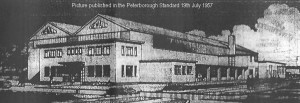 This picture of the new factory was published in the Peterborough Standard newspaper in July 1957. To read a transcript of the full article, click here.
This picture of the new factory was published in the Peterborough Standard newspaper in July 1957. To read a transcript of the full article, click here.
PHASE 2.
The need for more space continued, and the mid-1960s saw a major building program to expand the production area by the addition of a third bay, and enlarged office facilities at the front of the building.
In addition, a new single storey extension was added to the east side of the new bay. This was built to accommodate an enlarged drawing office which combined design and drawing staff from both No.1 and No.2 factories, together with tracers, and the Brisch code system staff.
The picture on the right shows this new drawing office.
[[We believe we can name most of the staff shown here, which include Ray Hill, Ray Morris, Brian Beecham, Brian Simpkins, and Sid Russell. It becomes immediately clear that this picture was taken in an age before the computer replaced the drawing board, and the mouse replaced the pencil!]]
At the southern end of Bay 3, a large temperature controlled room for machine testing was constructed which met the environmental standards laid down by the National Physical Laboratory. The room was large enough take 3 or 4 jig Borers, together with their hydraulic unit, electrical panel and the operator panel(s). It was in this room where jig borers were given their final (pre-shipping) tests, and where customers could observe these tests to confirm that the machines met their required specifications.
This room had a very large sliding door, to provide access for moving large machines in and out. Within this door was a smaller door to allow personnel access. On that smaller door, a Ministry of Technology, Calibration Service plaque (similar to that shown above for the No.1 factory laboratory) reminded everyone that they were entering an environmentally controlled area.
In the early 1980’s, a rather impressive (and quite expensive) automatic cam form inspection machine was also located here. This machine (manufactured by Adcole) used a laser measuring system to check cam forms against a set of master data, and produced graphs displaying form errors to an accuracy of a few microns. It could also check the dimensions and roundness/ovality of crankshaft journals.
To the south of the main manufacturing bays, new buildings were constructed to house the stores, the Hydraulic Shop, Spindle Shop and Machine Shop.
In order to meet Newall’s manufacturing standards the company needed a skilled workforce, and had for some years been operating an apprenticeship scheme, specifically covering machining processes. Initially, this training was carried out at the No.1 factory, but in the early 1960’s moved to a new Apprentice School building constructed to the south of the No.2 site.
The following two photographs are of the apprentice school. The caption published with these photographs states that “The Newall Apprentice Training School at the No. 2 factory provides the Company with a constant supply of thoroughly trained young men, skilled in many aspects of machine tool manufacture. The apprentices seen below are trained with the aid of a wide variety of machine tools and equipment.”
In January 2021, information from Brian Strickson (an appreantice starting in September 1968) listed Mr F J Pasby as the head of the training department, and Bryn Hancock (seen in photo above/right), Mr Miller and Mr D Dexter as trainers.
An aerial photograph of the site was published in one of the company sales brochures, and is reproduced above.
Once again, our thanks to Ray Morris for the following photographs, also showing the factory during this ‘phase 2’ stage.
On the right, a view of the factory taken from near the junction of Shrewsbury avenue and Oundle Road.
Below, on the left, a photograph of Bay1, used for jig borer assembly; and on the right, a photo of Bay2, used for grinder assembly.
Below, on the left, is a photograph of the panel assembly section, and below right, is the spindle assembly shop. The document from which this photograph was taken states that “spindle assembly is carried out in rigorously controlled conditions to help maintain the highest possible standards of work in this important section.”
Equally important for the company was the work carried out by their spindle inspection department. The two photographs below shows “a team of inspectors carefully checking accuracy and quality” of the assembled spindles (on the left), and a spindle test rig in the same department (on the right).
[[We are not absolutely certain that all the above photographs were taken at the No. 2 factory. Some, particularly those relating to spindle inspection may have been from the No. 1 factory. If anyone out there can provide more information on this, we’d be interested to hear. Please email Mike at the email address given at the top of this page, or use the form on our feedback page. ]]
The caption accompanying the two photographs below stated that “Continuing improvement to Newall machine tools is made possible by an active Research and Development section. Two scale perspex models of the SA High Speed grinding machine are seen here being subjected to vibration analysis.”
In the early 1970’s, the No.1 factory closed, and the resulting re-organisation meant that all the engineering functions were concentrated at the No.2 factory.
The No.2 factory was also the base of the fledgling electronics division. This side of the business expanded significantly over this phase 2 period, eventually moving out to the Padholme Road site (see below) where more space was available. Refer to our Newall Electronics page for further information on this side of the Newall story.
PHASE 3.
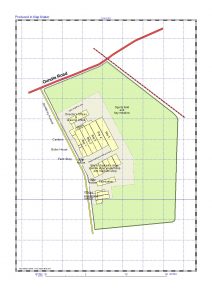 In the late 1970’s, and following the takeover by B Elliott, a further phase of expansion took place. This was necessary for two reasons. Firstly, the company’s generic machine tool business was expanding, and secondly, the company had acquired the roll grinder business of Churchill Machine Tools in Coventry, and decided to move that business to Peterborough.
In the late 1970’s, and following the takeover by B Elliott, a further phase of expansion took place. This was necessary for two reasons. Firstly, the company’s generic machine tool business was expanding, and secondly, the company had acquired the roll grinder business of Churchill Machine Tools in Coventry, and decided to move that business to Peterborough.
The most obvious effect of this expansion was the construction of two new bays.
Bay 4, which was a wider than bay3, replaced the single storey drawing office building previously on the east side of bay 3.
Bay 5 was an even larger construction which was necessary to accommodate the assembly and test of the large Churchill roll grinders. We understand that the floor foundations required in order to support these ‘massive’ machines were significantly more extensive than was required for the company’s other products. We have been told that the depth of the reinforced concrete base will present some problems for any contractor taking on the task of removing it!
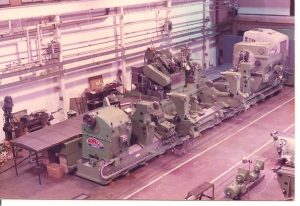 This photograph is of a roll grinder being assembled in the new Bay 5. Unfortunately, in this photograph, there is no one standing near the machine which would have given an idea of the machine’s size.
This photograph is of a roll grinder being assembled in the new Bay 5. Unfortunately, in this photograph, there is no one standing near the machine which would have given an idea of the machine’s size.
Go to our ‘PRODUCTS – Page 3’ page for more information on roll grinders. Another photograph on this page does show two operators near the machine.
As well as the new production bays, the office facilities were significantly extended during this phase to accommodate the design and drawing office and the directors’ offices. These new offices were built around a small garden area, which still exists today (January 2016).
In the mid 1980’s, following a significant reduction in orders, and the consequential need to reduce capacity, this factory closed and most of the workforce were made redundant.
In late 2021 it came to our attention that the 5 bays forming the majority of this factory had been demolished. You can get an idea of how the site looked before, and immediately after demolition in the following two screenshots taken from Bing Maps and Google Maps websites respectively:
Padholme Road Works (No.3 factory)
First used 1960 – Closed (mid 1970’s)
A third facility was in Padholme Road. This site first commissioned by the company in the early 1960s and was initially used for “the manufacture of the company’s range of lapping machines and fine borers” (see ‘Machinery’ article, page 12). Later, the factory became the centre for the building of machine control panels and operator panels. The Company’s engineering R&D centre moved here from about 1966.
In late 1969, the production department for the company’s Electronics division moved to the upper floor office area, to be followed in 1970 by the same division’s design office. We would estimate that in circa 1974 the electronics division moved out of the No.3 factory to new offices in Ivatt Way, Peterborough.
The No.3 factory closed in mid 1970’s, but see our Addendum page for a little more information on how it came briefly to be used again in the 1990’s for Newall-related activities. At the time of writing (2018), the factory has stood empty for some years and has recently been fenced off and declared a dangerous building. You can see from this 2017 aerial image what a sorry sight it looks.
The office and assembly spaces used by Newall Electronics in their early days were in the long brick 2-storey extension along the right-hand side of the factory. The development labs and production areas were on the upper floor, with admin. and sales offices on the ground floor. In the early 1970’s the part of the main factory nearest the camera was used by the Newall Engineering mechanical development team (under Stan Hoare) during their investigations into high speed grinding techniques, while the rear part housed electrical control panel assembly at that time.
[[As is apparent from the above, we have limited information of Newall’s story relating to this factory. Hopefully we’ll be able to add more information in future.]]

